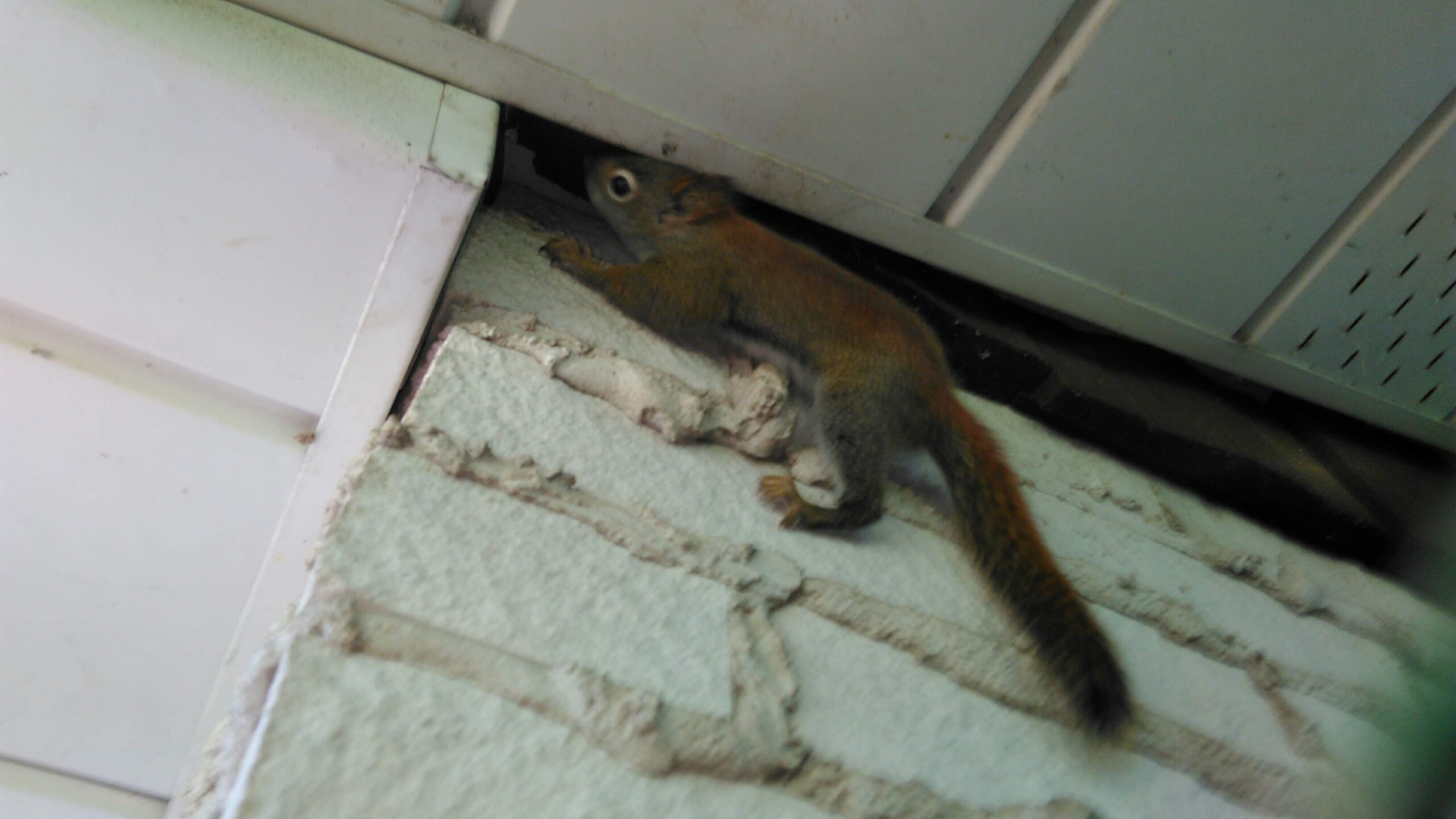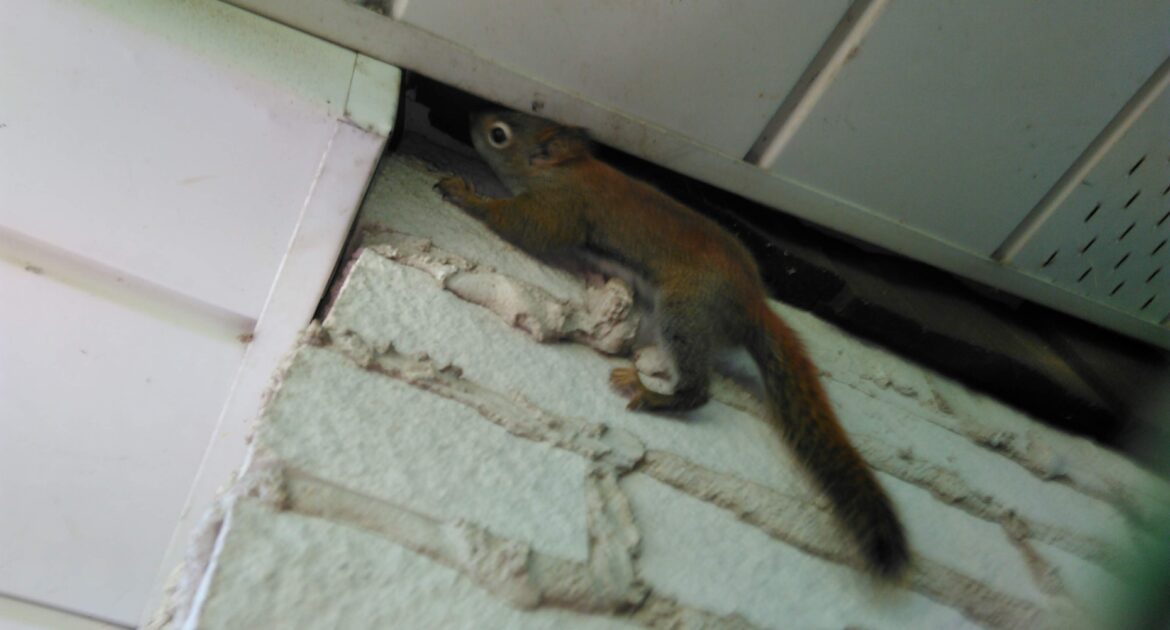Hearing odd noises coming from your walls or attic can be unsettling, especially when it sounds like scurrying or scratching. These sounds are often a telltale sign of a squirrel in your attic. Squirrels seeking shelter can find their way into your home, creating disturbances and potential damage.
Squirrels in your walls sound like they are persistently scratching as they nest or move around. Not only can their activities compromise your insulation, but they may also pose risks to your electrical wiring and structural integrity.
If you’re wondering how to get rid of squirrels in your attic and walls, it’s essential to address the issue promptly and professionally. Left unchecked, their presence can escalate into a more challenging problem, emphasizing the importance of a humane and effective solution carried out by experienced professionals.
How to Identify Squirrel Sounds in Your Home
The first step in identifying what might be lurking within your walls or attic is understanding the distinct noises squirrels make. The sounds tend to be subtle during the early stages of an infestation, but they can escalate over time as they settle into their new environment. Most commonly, you’ll hear scratching, scampering, or shuffling — almost as if something lightweight but fast is moving ardently between walls or across your ceiling. These sounds are especially common during the early morning or late afternoon when squirrels are most active.
What makes these noises so distinctive is their rhythm and frequency. Scratches might sound brief and frantic as squirrels claw at wood or drywall to build a nest, while scampering mimics little feet darting across surfaces. Occasionally, you may hear short bursts of chirps, squeals, or chatter. This vocalization is often tied to their nesting habits and is a way of communicating with other squirrels.
Recognizing the type of wildlife based on sound isn’t always straightforward, though. For instance, mice or rats might also produce scratching noises, but they tend to be softer and occur more frequently during the night, as these rodents are nocturnal. Raccoons, on the other hand, make heavier thumping sounds due to their larger size, and unlike squirrels, they are far less likely to move swiftly within confined spaces like walls. Bats create a fluttering noise that mimics the rustling of paper but lack the repetitive scratching or scampering squirrels often produce. Careful observation of these tell-tale noises over a few days can usually help identify what you’re dealing with.
Additionally, spotting secondary signs alongside the sounds can further confirm your suspicion. Check for chewed entry points near soffits, vents, or roof edges, as squirrels are quick to exploit even slight vulnerabilities. Droppings near access points or shredded insulation may accompany the audible disruptions and serve as additional evidence.
Why Squirrels Enter Walls and Attics
Understanding why squirrels are drawn inside can provide valuable insight into how to address their presence effectively. Typically, they don’t wander indoors randomly but do so intentionally when certain conditions align. The most common reason is the search for shelter, particularly during the colder months or leading up to winter.
Squirrels seek enclosed, warm locations to build nests where they can store food and raise their young. Your home can be an ideal candidate, offering insulation, protection from predators, and an environment shielded from weather extremes. Attics and walls often become prime targets due to their relative seclusion. The rise of urban development has increasingly displaced wildlife habitats, prompting squirrels to adapt to suburban and urban settings with remarkable ingenuity.
Squirrels are resourceful climbers, scaling trees or utility lines that give them direct access to your rooftop. From there, they can exploit small vulnerabilities in gutters, shingles, or ventilation grids. Damage to rooflines caused by weather, combined with routine wear and tear, becomes an unintentional invitation for them to enter. Additionally, the scent of pre-existing squirrels or other wildlife can attract newcomers, creating a cycle that becomes increasingly difficult to break.
Another important factor is the allure of food sources nearby. Bird feeders, gardens, or compost bins inadvertently turn your property into an enticing destination for squirrels. Though they might initially approach out of curiosity or hunger, once they discover the additional benefit of warm shelter within your home, they’re quick to commit to nesting inside. This dual attraction — food outside and an ideal nesting space inside — creates the perfect storm for an infestation.
How to Get Rid of Squirrels in Your Attic and Walls
If the noises have made it clear that squirrels are present, it’s essential to act promptly. Squirrels may start by causing moderate disruptions, but over time, their activity can lead to significant damage. They have strong teeth and clawed feet that can shred insulation, weaken wood structural supports, or even gnaw on electrical wiring, increasing the risk of fire hazards.
Start by performing a thorough visual inspection around your property and roofline. Look for holes the size of a golf ball or scratches near roof corners, soffits, or fascia. Check for signs of nesting material like twigs or leaves scattered near vents or eaves. Inside attics, shredded insulation and droppings around darker corners are indicators of their presence. Once their entry point and signs of activity are confirmed, immediate next steps should involve reaching out to wildlife control professionals rather than attempting DIY solutions.
Attempting to resolve squirrel infestations yourself often leads to incomplete fixes or unintended consequences. For example, sealing their entry point without verifying that squirrels have left risks trapping them inside, leading to increasingly frantic behaviour and potential health hazards from decomposing animals if they perish. Using poison or traps can also be inhumane, as well as create safety concerns for children or pets in the house.
Choose Skedaddle for Humane Wildlife Control In Ottawa
Our team at Skedaddle specializes in humane and comprehensive solutions for managing wildlife issues, including squirrels inside homes. What sets us apart is our approach, which is built on decades of expertise and a commitment to ethical animal handling. Unlike pest control services that focus on short-term fixes, we emphasize humane removal, exclusion, and prevention.
When you call Skedaddle, our professionals don’t just remove the problem — we identify vulnerabilities in your property that allowed access in the first place. We use durable materials to secure these areas, preventing future occurrences. Our service also includes cleaning and sanitizing any damage, such as droppings or destroyed insulation. This attention to detail ensures not just a return to peace of mind but also that your home remains clean, safe, and protected long after our team is gone. With Skedaddle, you can trust that our focus on humane practices aligns with your desire to tackle wildlife concerns ethically and efficiently.
Take Action Before the Problem Grows
Hearing unusual sounds in your walls or ceiling is never a situation to ignore. Whether it’s the scampering of squirrels, the rustle of insulation being disturbed, or the unexpected chatter of animals communicating, these signs are a clear indicator that immediate attention is needed. Left unchecked, the presence of squirrels in your home can escalate from nuisance to costly damage, and waiting only makes the challenge more complicated.
If you suspect squirrels may have taken up residence in your home, don’t hesitate to contact a professional wildlife control service in Ottawa to address the problem effectively and humanely. At Skedaddle, we’re ready to assess your situation and deliver comprehensive solutions tailored to your needs. Get the peace of mind you deserve by taking action today.




